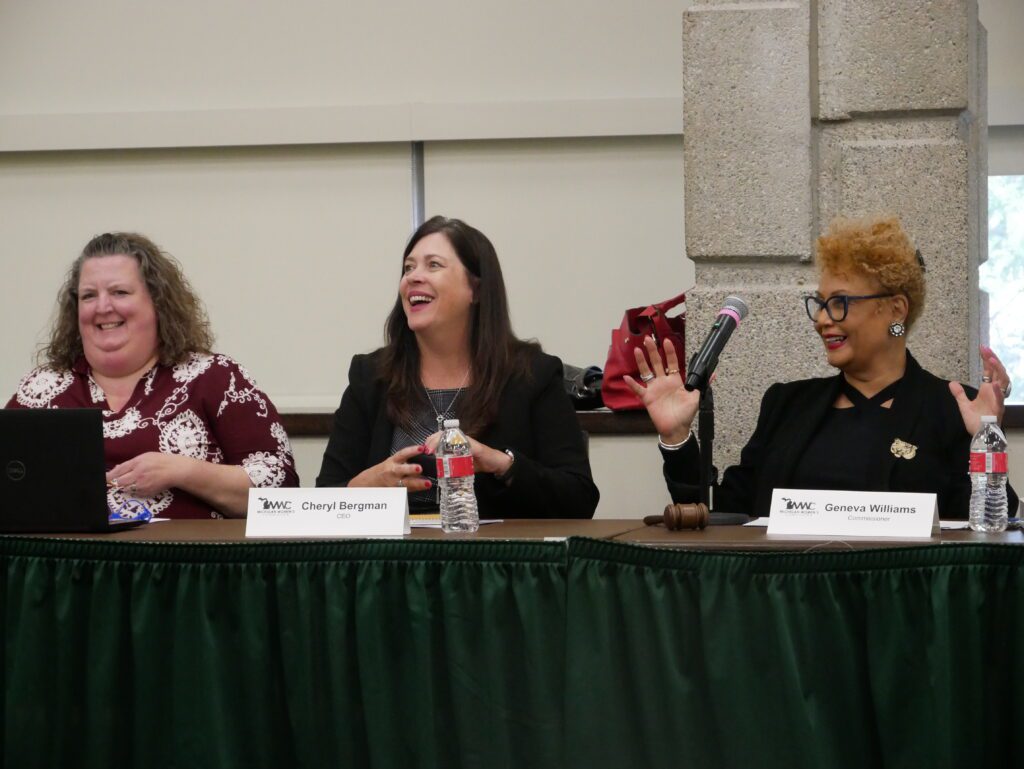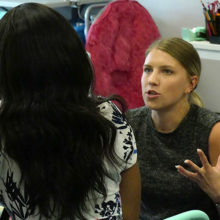

As the pandemic-era federal funding that propped up child care runs out — and the hope for Build Back Better becomes a memory — states are finding their own ways to cope with the ongoing crisis.
The so-called “funding cliff” has made the nation’s pre-existing child care challenges worse, causing closures of programs and classrooms, and increases in tuition and teacher turnover. All of this impedes the crucial development of America’s youngest learners, and impairs their parents’ ability to participate in the workforce.
In the absence of federal action, states have stepped up with their own solutions. At EdNC, a nonprofit news and research organization focused on expanding educational opportunities for all students in North Carolina, we got curious about how other states were coping.
EdNC’s early childhood team, with the help of student researchers at Duke’s Sanford School of Public Policy, identified five states that are leading the way in early childhood investment and policy. At the end of 2023, we visited Michigan, Massachusetts, Vermont, Oregon, and New Mexico, speaking with child care teachers, providers, advocates, organizers, business leaders, and other experts to learn how they got to where they are now.
Through our travels, we identified four strategies that most of these states have in place.
“The states that you’re looking at see this as a systemic issue and not the small, ‘It’s your problem, you deal with it,’ kind of thing,” said Whitney McCoy, a research scientist at Duke’s Center for Child & Family Policy.
A Michigan model that shares the cost of child care between state government, businesses, and parents is spreading across that state. In Oregon, leaders are tackling child care access from several angles with a new statewide early childhood department at the helm. In Massachusetts, the state is replacing federal relief dollars to avoid the child care cliff, and localities are expanding pre-K.
And in Vermont and New Mexico, recent legislative wins set up those states to create universal early care and education systems.
“First and foremost, we have to recognize this is a systemic problem and that it’s going to take a systemic solution,” said Kristi Snuggs, president of the Child Care Services Association.
Here are four ways states are doing that.




1. Advocacy from the business community
States leading early childhood policy are doing so with support from their business communities.
In many cases, policy leaders told EdNC, this support was not just helpful, but necessary for progress.
In Michigan, it was cross-sector leaders on the state’s Women’s Commission who heard of child care concerns from their parent employees and launched MI Tri-Share in response.
The program relies on businesses to cover a third of the cost of eligible employees’ child care. The other two-thirds is split between the employee and the state.
Employers are pitching in with an understanding that turnover costs them more than their share of that child care cost. Plus, recruitment is easier when companies offer benefits that parents desperately need, participating business owners told EdNC.
Models based on this program are catching on elsewhere, including Kentucky and New York. North Carolina will try one this year.


Business leaders also are showing up at statehouses to push for public policy and investment, and they’re showing up in communities to organize efforts that increase access to child care.
Advocates at Let’s Grow Kids (LGK), a Vermont nonprofit created to push for child care investment, assembled a team of business leaders from across the state and led a six-week sprint on early care and education.
Aly Richards, CEO of LGK, said business leaders at first wanted to see the budgets of child care programs, confident the problems could be solved with smart financial management. Then they showed them those budgets.
“They’re like, ‘Oh, I understand, this is a market failure. It’s a business model failure,’” Richards said.
In other words, child care businesses cannot create the desired product (high-quality care) at a price that is affordable for most parents. Treasury Secretary Janet Yellen in 2021 called child care “a textbook example of a broken market.”
Some of the Vermont business leaders also wanted to open on-site programs, Richards said. Advocates then explained the factors that would be draining on those operations, including a shortage of early childhood teachers.
“It’s not systemic, it’s not equitable,” she said.
Once the business leaders got on board that public investment was the only answer, LGK advocates gave them a list of Vermont’s revenue sources and asked them to choose a funding lever. The business leaders did an analysis, chose a payroll tax, and pushed for it in the legislature.
“Each of them said, ‘Tax me,’” Richards said. “Vermont makes more money, I make more money, my employees make more money, and we pay off this payroll tax surcharge, basically, before half the year’s over. That was the sort of final thing that pushed us over the finish line.”


2. Grassroots organizing
The most powerful advocacy efforts in the states EdNC visited centered the people most affected by the policies they were backing.
On the local level, the activism of parents with young children led to the passage of Multnomah County’s Preschool for All initiative in Oregon, which is working toward universal preschool access for 3- and 4-year-olds through a marginal tax on high-income residents and workers.
The Parent Accountability Council (PAC) formed a vision for pre-K access that went beyond state program standards.
“We wanted classrooms that look like us,” said PAC member Lydia Gray-Holifield. “We wanted classrooms that spoke our languages. We wanted classrooms that greeted our parents when we walked in the door. We want our kids to feel safe and comfortable.”
The PAC held regular community focus groups and cafes, and then brought recommendations to the table.
Their input is now baked into the Preschool for All initiative, leading to program elements that are rare in public pre-K programs. They made sure the pre-K day lasted the full workday, that exclusionary discipline was not an option, that parents had a pathway to become teachers, and that all types of community providers were involved.
In some cases, successful advocacy is not about reinventing the wheel, but about consistency and determination, leaders told EdNC.
Related reading
Advocates in Massachusetts created a simple tool that kept everyone in the early childhood community on the same page throughout and since the pandemic: the 9:30 call.
In March 2020, advocates started holding an open Zoom meeting with the same link every day, five days a week, to share challenges, ask questions, and tell decision-makers how policies were playing out. The call outlasted the pandemic as a way to coordinate efforts and connect early childhood professionals across the state with experts and elected officials.
“It has changed the way we do everything,” said Amy O’Leary, executive director of Strategies for Children, a nonprofit. “I call it unfiltered advocacy.”
More than 1,400 people have joined the calls, with a daily attendance of 75 to 100. The call has helped a broader geographic representation be involved in creating a statewide Early Childhood Agenda. Now other leaders are looking at the tool as a case study for building community virtually.
In both Vermont and New Mexico, advocates rallied behind electoral candidates who were committed to passing early childhood policies.
“They basically removed the barriers at the legislative level, and put in people that were friendly to early childhood,” said Catron Allred, director of the Early Childhood Center for Excellence at Santa Fe Community College.
Let’s Grow Kids in Vermont created a dashboard of 40,000 people who have engaged with the campaign to pass Act 76 over a decade. That’s 5% of the state’s population. Advocates sat at farmer’s markets and fairs to talk to passersby about child care and ask for contact information or signatures.
When a legislative committee needed to hear about child care issues, it would take only a couple of minutes to send out an accessible form through the dashboard for people to share their stories.
“When we started using that, it really upped the game,” said Shayla Zammuto, senior field manager for LGK. “Like thousands and thousands and thousands of messages into legislators each session — it’s really hard to ignore.”


3. Streamlining governance
Governance structures matter, experts from every state told EdNC.
While EdNC was in Michigan, a new department was announced, the Department of Lifelong Education, Advancement, and Potential, that brings together programs from early childhood to higher education, including MI Tri-Share. It was a necessary step for the statewide expansion and long-term sustainability of the program, said Cheryl Bergman, CEO of the Women’s Commission.
In Vermont, a public-private partnership called Building Bright Futures provided essential support to the Democratic-led legislature and the Republican governor’s office during the passage and implementation of Act 76.
The organization sits outside of state government, and its members advise both the legislature and the executive office on early childhood policy. They bring together a network of 500 people monthly through 12 regional councils. They do not advocate for any particular policy, but present data and input from across the state to elected officials.
“It’s really about saying, based on these conversations with community partners, with families, with the state advisory council, and our other network bodies, this bill is well-aligned with what we’re hearing,” said Anna Brouillette, the group’s policy and program director.
The group is able to hold the state’s early childhood vision through political turnover, a thread we noticed in several states. In New Mexico, for example, the Legislative Finance Committee — a body that combines fiscal analysis and program evaluation — was able to act as a nonpartisan, research-backed voice through several gubernatorial administrations and legislative turnover.
In 2019, Oregon created a standalone early childhood department. New Mexico followed suit in 2023.
The creation of new departments has helped bring policies and programs from several agencies under one umbrella to better coordinate services and make navigating those services easier for families. It’s also made sure early childhood issues are not lost within larger departments and conversations.
“We wouldn’t be able to have conversations in the same holistic way and coordinated way and leverage the funding that we have from the feds and the state together to solve any of these issues — access, quality, workforce — that exist in our field, without a cabinet-level agency,” said Sara Mickelson, deputy cabinet secretary of New Mexico’s Early Childhood Education and Care Department.








4. Identifying/creating new funding streams
Early care and education is expensive. The cost is being subsidized now through high costs for parents and low wages for teachers.
As state governments play a bigger role in covering that cost, they are finding new sources of funding to help parents afford care and to raise teacher pay.
In some cases, those are funds earmarked for early childhood out of a larger pot of money.
The Land Grant Permanent Fund, through a constitutional amendment in New Mexico, has been opened to early childhood, sending about $150 million to the Department of Early Childhood Education and Care annually. The fund, the largest of its kind in the country, is financed by leases and royalties on non-renewable natural resources in the state. It will send $1.34 billion to beneficiaries (mostly K-12 public schools and universities) this fiscal year.
In Oregon, the Student Success Act of 2019 sends 20% of its annual $1 billion distribution to the state’s Early Learning Account.
Every year about $10 million from the account is reserved for the Early Childhood Equity Fund, which goes exclusively to culturally specific organizations “that focus on closing opportunity gaps for children and families who face historical and current inequities due to factors such as race, income, zip code, or language,” its website reads.
In other states, increased taxes or new mechanisms are sending consistent public funding to early childhood systems.
For example, New Mexico’s legislature in 2020 established the Early Childhood Education and Care Fund, which is funded by oil and gas revenue and dedicated to early childhood programs and services. The fund sent $150 million to early care and education last year, with projections to send $486 million annually by 2028.
And just last year, Act 76 in Vermont established a Child Care Contribution, consisting of a 0.44% payroll tax and a 0.11% self-employment income tax. The tax will provide $125 million in child care funding annually.
Each of these streams is specific to the state’s context and resources. But they are “all based on a key principle that public investment is the missing piece of the puzzle,” said Richards from LGK in Vermont. “Period.”
Behind the Story
In the fall of 2023, EdNC’s early childhood team visited five states leading the way in early childhood policy and investment. In January of 2024, EdNC published an article with insights from that research for North Carolina. This piece is an edited version without North Carolina’s context to share lessons with a national audience.
This post was originally published on 3rd party site mentioned in the title of this page







